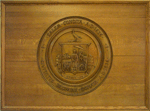Abolitionists: Difference between revisions
No edit summary |
No edit summary |
||
| (7 intermediate revisions by 2 users not shown) | |||
| Line 1: | Line 1: | ||
Salem has been home to many abolitionists over the years. The harbors, river and access to the sea made it an important escape route for runaway slaves to Canada. Many free blacks, white liberals and religious leaders supported | Salem has been home to many abolitionists over the years. The harbors, river and access to the sea made it an important escape route for runaway slaves to Canada. Many free blacks, white liberals and religious leaders supported the abolition of slavery, believing slavery was an issue best dealt with in the Southern states. | ||
Some of the local abolitionists: | Some of the local abolitionists: | ||
''Prince Farmer'', a black businessman who sold oysters, lived at 18 Crombie | ''Prince Farmer'', a black businessman who sold oysters, lived at 18 Crombie Street in 1844-45.) Mr. Pike (owner of 18 Crombie St.) was a member of the Masonic fraternity and an important member of the abolition movement in the city. | ||
''Sarah Parker Remond'', a member of one of the prominent African American families in Salem. A founder of the Salem Female Anti-Slavery Society, this group sponsored lectures at the Salem Lyceum by important abolitionists, such as Lucy Stone, Charlotte Forten and William Lloyd Garrison. See [[Remond, Sarah Parker|Sarah Parker Remond]] entry for more information. | ''Sarah Parker Remond'', a member of one of the prominent African American families in Salem. A founder of the Salem Female Anti-Slavery Society, this group sponsored lectures at the Salem Lyceum by important abolitionists, such as Lucy Stone, Charlotte Forten and William Lloyd Garrison. See [[Remond, Sarah Parker|Sarah Parker Remond]] entry for more information. | ||
| Line 17: | Line 17: | ||
==See Also== | ==See Also== | ||
[ | *[https://sarahparkerremond.wordpress.com/2011/07/21/abolitionists-and-the-underground-railroad-in-the-essex-national-heritage-area/ Abolitionists and the Underground Railroad in the Essex Nation Heritage Area] Essex National Heritage Area | ||
*[http://salem.noblenet.org/Record/1711905 The Underground Railroad in Massachusetts] by Wilbur Siebert, p. 32-46 | |||
Latest revision as of 15:56, 24 November 2025
Salem has been home to many abolitionists over the years. The harbors, river and access to the sea made it an important escape route for runaway slaves to Canada. Many free blacks, white liberals and religious leaders supported the abolition of slavery, believing slavery was an issue best dealt with in the Southern states.
Some of the local abolitionists:
Prince Farmer, a black businessman who sold oysters, lived at 18 Crombie Street in 1844-45.) Mr. Pike (owner of 18 Crombie St.) was a member of the Masonic fraternity and an important member of the abolition movement in the city.
Sarah Parker Remond, a member of one of the prominent African American families in Salem. A founder of the Salem Female Anti-Slavery Society, this group sponsored lectures at the Salem Lyceum by important abolitionists, such as Lucy Stone, Charlotte Forten and William Lloyd Garrison. See Sarah Parker Remond entry for more information.
William Ingersoll Bowditch (son of Nathaniel Bowditch) was an abolitionist. He lived at 9 North Street.
John Bertram provided financial support for the education of freed slaves. See John Bertram entry for more information.
Supreme Court Justice, Joseph Story, was involved in the U.S. Supreme Court decision concerning the vessel the Amistad. When the court found that the group of Africans taken from their homeland were free men and victims of kidnapping, a significant victory was made for the abolitionist movement.
See Also
- Abolitionists and the Underground Railroad in the Essex Nation Heritage Area Essex National Heritage Area
- The Underground Railroad in Massachusetts by Wilbur Siebert, p. 32-46
